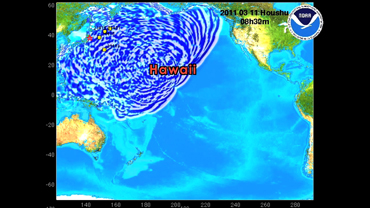Transcript
It can be many miles long, from 1 to 100 feet high, traveling at 400 miles per hour. This ocean monster is known as a tsunami and it can wreak havoc on coastal populations and landscapes.
A tsunami is a series of ocean waves caused by any large and sudden disturbance of the sea surface. Tsunamis can be generated by landslides, volcanic eruptions, or even meteorite impacts in the ocean. But they are most often caused by an earthquake where there’s a sudden displacement of the ocean floor.
When that happens, there’s a transfer of energy from the seafloor to the ocean, causing waves on the surface to radiate outward in all directions. In deep waters, these waves may not even be detectable. But when the tsunami enters shallower waters, the wave speed slows and its height increases. The water along the coast may recede noticeably. A large wall of turbulent water, called a “bore,” may also form.
When the tsunami hits, it may come ashore like a fast rising flood and strike with devastating force. The series of waves may continue for hours. The first one may not be the last or the largest. For your safety, know the potential warning signs of an incoming tsunami: a strong earthquake that causes difficulty standing; a rapid rise or fall of the water along the coast; a loud ocean roar.
When you’re in a coastal area, it’s important to keep alert for messages from local officials, such as lifeguards, police, The US Tsunami Warning Centers and NOAA All Hazards Radio.
If you find yourself in a location of a tsunami strike, here’s what you need to do to stay safe: keep calm; walk or run to higher ground, 100 feet above sea level or 1 mile inland;
do not drive – keep roads open for emergency vehicles; if you cannot move to higher ground, use the stairs to get to the third floor or higher in a sturdy building; follow all instructions from local officials, and stay out of coastal areas until authorities issue an “all clear.”
Tsunamis can strike any coastline in the world, and can affect locations thousands of miles away from where they formed. They may be uncommon, but the devastation they cause makes them a deadly force in nature.
 An official website of the United States government.
Here's how you know we're official.
An official website of the United States government.
Here's how you know we're official.







